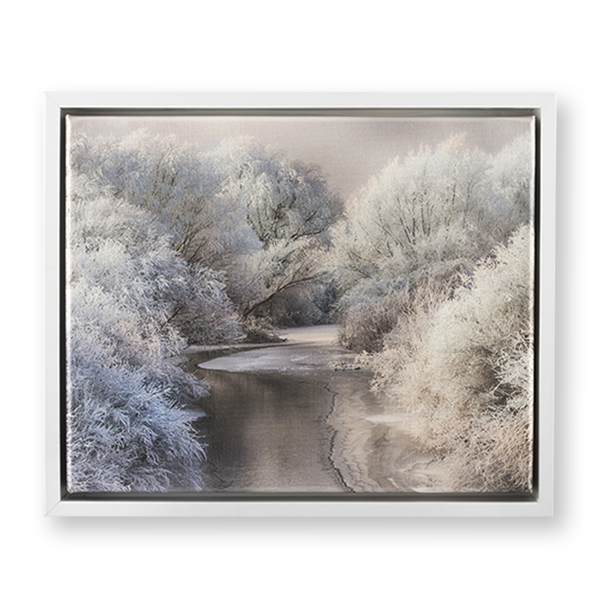
08/09/2023
by Laura Gardiner
Studio Manager, Tribeca Printworks
Canvas prints are popular because they are affordable and incredibly durable artwork. The canvas used for prints has a bright white coating, resulting in a vibrant finish. You can also choose a matte, glossy, satin or metallic finish for your canvas print. Canvas frames help to elevate the artwork and give it an elegant look.
Many pieces of art are flat, making them simple to frame. Canvas prints come rolled up, so you will need to stretch them before framing. This process requires supplies and careful technique to ensure the canvas fits perfectly into the frame. At Tribeca, we have extensive experience working with canvas prints and provide high-quality, custom canvas framing to complete your piece.
This seven-step guide details the ins and outs of framing a canvas.
How to Frame Canvas Art
Framing canvas print is an art that requires skill and special techniques. The following steps include preparing, framing and maintaining framed canvas art.
1. Choosing the Right Frame
Custom frames are available in various materials, styles and colors, so you have many options. Before you choose a frame, consider the style and aesthetic of the artwork. The frame you choose must compliment your canvas print instead of overpowering or dulling its presence. For example, a darker frame on a light canvas print can create a striking effect. Classic pieces pair well with more traditional, ornate frames.
If you’re unsure what color to choose, white or black pairs well with various styles. These colors also work well with most interior decor. Another important factor is the space where you will display your artwork. Make sure that your piece pairs well with the surroundings.
2. Measuring the Canvas Print
Measuring your canvas print for framing is a crucial step. Firstly, you’ll need to leave enough of the canvas on the edges to fold over the stretch bar. Your measurements must be accurate to ensure the print fits perfectly into the frame. Canvas prints aren’t always square, so it’s wise to measure the canvas’s top, middle and bottom to get accurate dimensions.
Position the canvas in the way that you would view it. Measure the height, width and thickness of your piece. Include the folded corners, as these can add up to a 1/8 inch to your measurements. If your dimensions vary, choosing a frame according to the largest measurements allows for proper spacing and alignment.
3. Preparing the Frame
If your print is on a rolled canvas, stretch it before framing. You’ll need to gather the following supplies:
- Stretch bar frame
- Staple gun or screwdriver and screws
Start by stretching your frame using these steps:
- Make sure that your space is clean and clear of dust and dirt.
- Place your canvas print face down. To ensure it is lying flat, measure the distance from each corner.
- Place your stretch bar on the canvas and start by folding the shorter sides over the bar. Staple or screw the canvas to the bar in the middle of the folded pieces. Repeat the folding and stapling on all sides.
- Once each side has a single staple in the middle, pull the canvas slightly but allow enough leeway for it to expand. Add staples or screws on either side of the middle ones.
- Finally, pull tightly on the corners, cut off the lips and staple them to the stretch bar. You can add your final frame once your canvas is attached to the stretch bar.
A stretched canvas print is much easier to frame. You can choose a wooden picture frame or a floater frame specifically designed for canvas prints. A floater frame also circumvents the need for glass over your piece. The depth of your canvas print will also determine the type of frame you choose. Choose a frame with a rabbet depth deeper than the canvas stretch bar for a good fit. The following steps can help you to frame your canvas using a floater frame:
- Start by removing the protective packaging and covers. Clean the frame using a soft, lint-free cloth to remove dust and debris.
- Place your canvas face down on a clean surface and position the floater frame over it. The frame should rest on top of the stretch bar.
- Centre your canvas by ensuring that all the visible sides of the stretch bar are equal.
- Place an offset clip on the bottom center of the floater frame with the screw hole on the stretch bar. Screw it into the stretch bar, not the frame. Repeat this on the top center of the stretch frame.
- Turn your canvas over to check that it is centered. Adjust if needed, then add the offset clips on the left and right sides of the frame.
- Do a final position check of your frame and add more offset clips as needed.
4. Adding Mounting Hardware
The type of mounting hardware that you use will depend on the size and weight of your canvas and frame. D-ring hangers are the perfect solution for mounting small and large canvas prints. To mount your artwork using D-rings, you need the following:
- D-ring packet (D-rings, screws and wire)
- Screwdriver
- Wirecutters
- Measuring tape or ruler
- Pencil
To attach your D-rings:
- Measure and mark ⅓ of the way down from the top on your frame’s left and right sides.
- Attach one D-ring at each marked point, with the ring facing the top of your frame.
- Loop the wire through one of the rings, leaving a slight excess at the end to wrap around the wire.
- Loop it around the second ring and secure it by wrapping the extra wire at the end around itself.
- Leave some slack in the wire to make it easy to hang.
5. Mounting the Canvas Print
Before you hang up your canvas print, you’ll need a strategy. Think about the orientation. Are you hanging it in landscape or portrait? Where will you be hanging it? Is the wall made of brick or drywall and can it take the weight of the print?
Gather your supplies, such as wall anchors or hooks, a hammer, nails, measuring tape and a pencil. Start by measuring and marking your desired height on the wall. For an ideal viewing experience, the center of your artwork should be 57 inches above the ground—the average eye level.
Mark off where the middle of your piece will sit. From the middle, measure where the nail or the wall anchor will catch the wire. Hammer your nail into the wall and leave it protruding enough so that you can loop the wire around it and hang your canvas.
6. Inspecting and Adjusting
Once you’ve mounted your framed canvas, carefully inspect it for any visible flaws or misalignments. Adjust the mounting hardware, canvas or frame to position it properly. Secure any loose components and tighten screws to ensure your artwork is securely mounted and prevent it from falling. Peek behind the frame and check that the wire is securely hooked over the nail and won’t easily slip off.
7. Cleaning and Maintenance
The best way to clean your framed canvas is by dusting it regularly. Gently wipe the frame or the glass with a soft, lint-free cloth. If dust builds up on the artwork, it will lose its color and become dull. Avoid using harsh chemicals or abrasive materials that damage your canvas or frame. Dip your cloth in the water and wring out excess water. Gently wipe the canvas in one direction, avoiding circular motions or scrubbing.
Custom Frame Your Canvas Print With Tribeca Printworks
Framing your canvas print addds the perfect finishing touch to your artwork. While you may consider framing your canvas print yourself, skilled framers have the expertise to help you choose the ideal frame and ensure a professional finish for your piece.
At Tribeca, our custom frames are hand-made for an immaculate result at a fraction of the cost. Framing canvas prints is an art, and because we handmake our frames in-house, we can customize yours to match any size canvas. To create a custom frame for your canvas print, contact us today!

